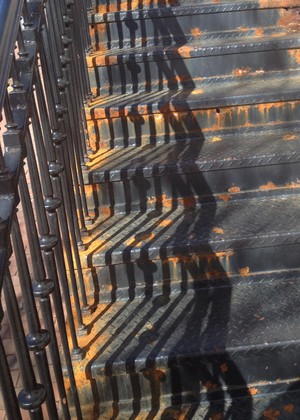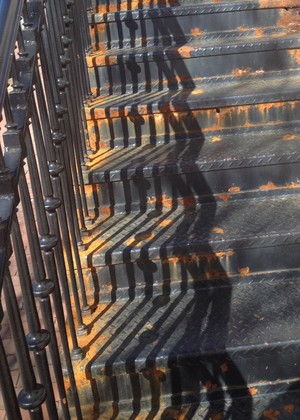One Staircase, Twice

- SUBSCRIBE
- ALREADY SUBSCRIBED?
BECOME A BONJOUR PARIS MEMBER
Gain full access to our collection of over 5,000 articles and bring the City of Light into your life. Just 60 USD per year.
Find out why you should become a member here.
Sign in
Fill in your credentials below.
 It couldn’t last. Of course it couldn’t, and I should have known better and spared myself the trip back to see it and the disappointment— more than that, sadness really, and lots of deep sighing—that smacked me in the teeth as I looked. But I knew it had been there obviously for some time—nothing gets that beautiful all at once—so maybe it was an objet for the owner of the building as much as it was for me, an urban artifact, found art or Merzkunst, an act of nature if not a miracle of a saint. I should have known.
It couldn’t last. Of course it couldn’t, and I should have known better and spared myself the trip back to see it and the disappointment— more than that, sadness really, and lots of deep sighing—that smacked me in the teeth as I looked. But I knew it had been there obviously for some time—nothing gets that beautiful all at once—so maybe it was an objet for the owner of the building as much as it was for me, an urban artifact, found art or Merzkunst, an act of nature if not a miracle of a saint. I should have known.
When I was twelve, I had a better excuse when I insisted on going back to a restaurant as a special treat that I had thought wonderful and beautiful when I was seven, but I was only twelve after all and twelve-year olds don’t know better, don’t anything, but I did learn something that day. I have no excuse now… except for hope. Remaining hopeful as the many years go by turns out to be a risky business, and a sad one.
And the staircase turned out to be a reminder. There was initially, I’m pretty sure, nothing extraordinary about it, the kind of exterior metal staircase, running up the side of a building to an apartment or an office or a storage space, that you will see anywhere discreetly tucked out of the full-frontal view of the storefront. Nothing about it says Paris or New York or Nairobi—it’s an off-the-shelf solution to the minor architectural problem of saving space by putting the stairs outside. It is ordinary, banal, not naturally much to look at, and that is what it is supposed to be.
Perhaps because it was ordinary, because no one ever gave it a second thought, it was left alone, left in peace, left to go the way of all steel sitting outside in the wind and the weather. Which means the rain and the sun and the comings and goings of feet over the years had worn off the paint and let it rust. I looked at it—as you can now—and thought it was beautiful, something that stopped me as I wandered aimlessly along, surprised by a simple visual pleasure. It was not spectacular or glamourous (my camera and I together are not good enough to do that), just lovely, unexpected, eccentric, I suppose.
Bohemian or riff-raff or low-rent might be the words someone else would use, particularly the owners of the store. I can’t remember what was there when I took the picture, rust and all, the shadow and the Hallowe’en colors adding a depth and character, the chiaroscuro of black and orange, to the banal metal stair treads. But when I pass again, the store is an elegant boutique selling very expensive men’s clothing. The windows show several copies of the same suit, all in a rather flat not-quite-dove gray, so dull, so not-there that even my accountant, I am sure, would have looked away in horror at its emptiness.
The suit, repeated four times on four manikins, is preposterous as only something fashionable can be. The jacket is about five centimetres too short, its sleeves at least three, ditto the cuffs of the trousers. It looks outgrown, showing off too much buttock, wrist and ankle. It looks as if it has escaped from Peewee Herman’s wardrobe, jumped over the wall and made a run for it. You hope that the animal control officers will shoot it on sight or, more humanely, grab it, still foaming at the mouth, and bring it to the pound were it can be, still humanely, put out of its misery.
Next year, the boutique may sell baggy suits with coats down to the knee and cuffs hiding the hands and the shoes, but that’s their business. The staircase is mine, and it cannot be restored by the passage of a couple of months and a new decree in taste for people who have none of their own. An establishment selling such suits—and at such prices—could not have a riff-raff, low-rent staircase, no matter how discreetly off-center, anywhere near its wares. Might as well have dirty fingernails or take the doors off the dressing rooms. Some things cannot—should not, may not—be seen, not here, not ever. Of course.
 Of course. They painted the staircase, not in the not-quite-dove gray of the suit (might show dirt), but in basic black. The little black staircase is always in season, no? The paint is fresh enough that some sheen remains and here and there picks up light, giving a fragment of sparkle, but not much. Only one thing holds the eye as I look at it, the shadow of the railing, but that is black on black, a kind of obverse of Malevich, precious (or boring) in an art gallery, of no interest to me. If there is such a thing as oscuroscuro, this is it, dark competing with dark, getting nowhere, un match nul.
Of course. They painted the staircase, not in the not-quite-dove gray of the suit (might show dirt), but in basic black. The little black staircase is always in season, no? The paint is fresh enough that some sheen remains and here and there picks up light, giving a fragment of sparkle, but not much. Only one thing holds the eye as I look at it, the shadow of the railing, but that is black on black, a kind of obverse of Malevich, precious (or boring) in an art gallery, of no interest to me. If there is such a thing as oscuroscuro, this is it, dark competing with dark, getting nowhere, un match nul.
If I wanted, I could wonder if the fashionistas and the mauviettes who might buy anything in this store have ever noticed the staircase, rusty and beautiful or black and absent, wonder if the boutique has gained a single customer or sale by painting the staircase or would have gained any of each by leaving it alone, wonder if I could explain to the proprietors what I think and ask them what they think. What ever for? It’s done.
It does not matter, except for the disappointment, and that just goes into one side of the ledger at the bottom of a long column—which no doubt will get longer. The good news is that I can turn my back on the display windows and the staircase and see life as it is, not as splendid Oz where fingernails are always clean, no one ever sneezes or farts, metal does not rust, and everyone is dressed in the fashion of the moment, pending the moment’s change in about three months. I can turn my back or walk for a few minutes and be away from the bourgeois desire to be like the very rich who do not need to own overcoats and umbrellas because they are never exposed, like old metal staircases or you and me, to the wind and the rain, for whom everything is always tidy, shipshape and spick-and-span.
Why even think about it? The world isn’t going to be prettied-up out of all pleasure and reason any time soon. Anyway, I can delete the picture of the freshly painted staircase from my camera and never go by the boutique again. Or, better yet, I can take a short walk to a café where I can get a passable glass of Sancerre and black olives, and where the chairs around the tables on the sidewalk do not match.
More in french life

